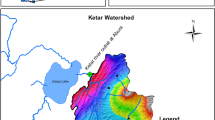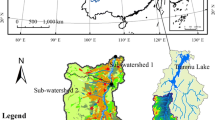Abstract
Semi-arid environments are generally more sensitive to urbanization than humid regions in terms of both hydrologic modifications and water resources sustainability. The current study integrates hydrologic modeling and land use projections to predict long-term impacts of urbanization on hydrologic behavior and water supply in semi-arid regions. The study focuses on the Upper Santa Clara River basin in northern Los Angeles County, CA, USA, which is undergoing rapid and extensive development. The semi-distributed Hydrologic Simulation Program Fortran (HSPF) model is parameterized with land use, soil, and channel characteristics of the study watershed. Model parameters related to hydrologic processes are calibrated at the daily time step using various spatial configurations of precipitation and parameters. Potential urbanization scenarios are generated on the basis of a regional development plan. The calibrated (and validated) model is run under the proposed development scenarios for a 10 year period. Results reveal that increasing development increases total annual runoff and wet season flows, while decreases are observed in existing baseflow and groundwater recharge during both dry and wet seasons. As development increases, medium-sized storms increase in both peak flow and overall volume, while low and high flow events (extremes) appear less affected. Urbanization is also shown to decrease natural recharge and, when considered at the regional scale, may result in a loss of critical water supply to Southern California. The current study provides a coupled framework for a decision support tool that can guide efforts involved in regional urban development planning and water supply management.








Similar content being viewed by others
References
Ackerman D, Schiff KC, Weisberg SB (2005) Evaluating HSPF in an arid, urbanized watershed. J Am Water Resour Assoc 41:477–486
Andriani GF, Walsh N (2009) An example of the effects of anthropogenic changes on natural environment in the Apulian karst (southern Italy). Envion Geol 58:313–325
Beighley RE, Dunne T, Melack JM (2008) Impacts of climate variability and land use alterations on frequency distributions of terrestrial runoff loading to coastal waters in Southern California. J Am Water Resour Assoc 44:62–74
Bhaduri B, Harbor JB, Engel B, Grove M (2000) Assessing watershed-scale, long-term hydrologic impacts of land use change using a GIS-NPS model. Environ Manage 26:643–658
Bicknell BR, Imhoff JC, Kittle JL Jr, Jobes TH, Donigian AS Jr (2001) Hydrological Simulation Program-FORTRAN (HSPF) User’s manual for Version 12. US Environmental Protection Agency. National Exposure Research Laboratory, Athens, GA
Bledsoe BP, Watson CC (2001) Effects of urbanization on channel instability. J Am Water Resour Assoc 37:255–270
Brun SE, Band LE (2000) Simulating runoff behavior in an urbanizing watershed. Comput Environ Urban 24:5–22
Caraco DS (2000) Stormwater strategies for arid and semi-arid watersheds. In: Schueler TR, Holland HK (eds) The practice of watershed protection article 66. Center for Watershed Protection, Ellicott
Chen YD, Carsel RF, McCutcheon SC, Nutter WL (1998a) Stream temperature simulation of forested riparian areas I: watershed-scale model development. J Environ Eng-ASCE 124:304–315
Chen YD, McCutcheon SC, Norton DJ, Nutter WL (1998b) Stream temperature simulation of forested riparian areas II: model application. J Environ Eng-ASCE 124:316–328
Choi W, Deal BM (2008) Assessing hydrological impact of potential land use change through hydrological and land use change modeling for the Kishwaukee River Basin (USA). J Environ Manage 88:1119–1130
Christensen NS, Wood AW, Voisin N, Lettenmaier DP, Palmer RN (2004) Effects of climate change on the hydrology and water resources of the Colorado River basin. Climatic Change 62:337–363
Chung ES, Lee KS (2009) Prioritization of water management for sustainability using hydrologic simulation model and multicriteria decision making techniques. J Environ Manage 90:1502–1511
DePoto W, Gindi I, Schleikorn M (1991) Hydrology manual. Los Angeles County Department of Public Works, Hydraulics/Water Conservation Division, Alhambra, California, p 79
Dettinger MD, Cayan DR (1995) Large-scale atmospheric forcing of recent trends toward early snowmelt runoff in California. J Climate 8:606–623
Donigian ASJ Jr (2002) Watershed model calibration and validation: the HSPF experience. National TMDL Science and Policy, 2002 Specialty Conference, 30:1, Water Environmental Federation, Alexandria, VA
Duda P, Kittle J Jr, Gray M, Hummel P, Dusenbury R (2001) An interactive windows interface to HSPF (WinHSPF) User’s manual, AQUA TERRA Consultants, Decatur
El-Kaddah DN, Carey AE (2004) Water quality modeling of the Cahaba River, Alabama. Environ Geol 45:323–338
Finkenbine J, Atwater J, Mavinic D (2000) Stream health after urbanization. J Am Water Resour Assoc 36(5):1149–1160
Gelt J (1997) Sharing Colorado River Water: history, public policy and the Colorado River compact. Water Resources Research Center Publication, University of Arizona, Tucson
Hayashi S, Murakami S, Watanabe M, Xu BH (2004) HSPF simulation of runoff and sediment loads in the Upper Changjiang River basin, China. J Environ Eng 130(7):801–815
Hayhoe K, Cayan D, Field CB, Frumhoff PC, Mauer EP, Miller NL, Moser SC, Schneider SH, Cahill KN, Cleland EE, Dale L, Drapek R, Hanemann RM, Kalkstein LS, Lenihen J, Lunch CK, Neilson RP, Sheridan SC, Verville JH (2004) Emission pathway, climate change, and impacts on California. PNAS 101:12422–12427
Hogue TS, Gupta HV, Sorooshian S (2006) A “user-friendly” approach to parameter estimation in hydrologic models. J Hydrol 320:202–217
Im S, Kim H, Kim C, Jang C (2009) Assessing the impacts of land user changes on watershed hydrology using MIKE SHE. Environ Geol 57:231–239
Keller AA, Zheng Y, Robinson TH (2004) Determining critical water quality conditions for inorganic nitrogen in dry, semi-urbanized watersheds. J Am Water Resour Assoc 40(3):721–735
Kim SM, Benham BL, Brannan KM, Zeckoski RW, Doherty J (2007) Comparison of hydrologic calibration of HSPF using automatic and manual methods. Water Resour Res 43(1):W01402. doi:10.1029/2006WR004883
Konrad CP, Booth DB, Burges SJ (2005) Effects of urban development in the Puget Lowland, Washington, on interannual streamflow patterns: consequences for channel form and streambed disturbance. Water Resour Res 41:W07009. doi:10.1029/2005WR004097
Land N (1999) Newhall ranch specific plan. Newhall Land, Valencia
Luo Y, Gao Q, Yang X (2007) Dynamic modeling of a chemical fate and transport in multimedia environments at watershed scale I: theoretical considerations and model implementation. J Environ Manage 83:44–55
Marcé R, Armengol J (2009) Modeling nutrient in-stream processes at the watershed scale using Nutrient Spiralling metrics. Hydrol Earth Syst Sc 13:953–967
McClintock K, Harbor J, Wilson T (1995) Assessing the hydrologic impact of land use change in wetland watershed: a case study from Northern Ohio, USA. In: McGregor D, Thompson D (eds) Geomorphology and land management in a changing environment. Wiley, New York, pp 107–119
Miller JR, Kochel RC (2010) Assessment of channel dynamics, in-stream structures and post-project channel adjustments in North Carolina and its implications to effective stream restoration. Environ Earth Sci 59:1681–1692
Moriasi DN, Arnold JG, Van Liew MW, Bingner RL, Harmel RD, Veith TL (2007) Model evaluation guildelines for systematic quantification of accuracy in watershed simulations. T ASABE 50(3):885–900
Mote PW, Hamlet AF, Clark MP, Lettenmaier DP (2005) Declining mountain snowpack in western North America. B Am Meteorol Soc 86:39–49
Murdock J, Roelke D, Gelwcik F (2004) Interactions between flow, periphyton, and nutrients in a heavily impacted urban stream: implications for stream restoration effectiveness. Ecol Eng 22:197–207
MWD (Metropolitan Water District) (2005) Metropolitan water District urban water management plan. Metropolitan Water District of Southern California, CA
NOAA-CSC (National Oceanographic Atmospheric Administration-Coastal Services Center) (2003) Southern California 2000-Era land cover/land use, LANDSAT-TM, 30 m. NOAA-CSC, Charleston
Ourso RT, Frenzel SA (2003) Identification of linear and threshold responses in streams along a gradient of urbanization in Anchorage, Alaska. Hydrobiologia 501:117–131
Pandey VP, Chapagain SK, Kazama F (2010) Evaluation of groundwater environment of Kathmandu Valley. Environ Earth Sci 60:1329–1342
Philips JR (1957) The theory of infiltration: the infiltration equation and its solution. Soil Sci 83:345–375
Quan RS, Liu M, Lu M, Zhang LJ, Wang JJ, Xu SY (2010) Waterlogging risk assessment based on land use/cover change: a case study in Pudong New Area, Shanghai. Environ Earth Sci. doi:10.1007/s12665-009-0431-8
Refsgaard JC, Knudsen J (1996) Operational validation and intercomparison of different types of hydrological models. Water Resour Res 32(7):2189–2202
Tiefenthaler L, Schiff K, Leecaster M (2001) Temporal variability patterns of stormwater concentrations in urban stormwater runoff. In: Weisberg SB, Hallock D (eds) Southern California Coastal water Research Project annual report 2000. Southern California Coastal Water Research Project, Westminster, pp 28–44
Tong STY, Chen W (2002) Modeling the relationship between land use and surface water quality. J Environ Manage 66:377–393
Toran L, Gross K, Yang Y (2009) Effects of restricted recharge in an urban karst system. Environ Geol 58:131–139
USEPA (US Environmental Protection Agency) (2004) BASINS 3.1: better assessment science integrating point and non-point sources 3.1. USEPA, Washington
Vicars-Groening J, Williams HF (2007) Impact of urbanization on storm response of White Rock Creek, Dallas, TX. Environ Geol 51:1263–1269
White MD, Greer KA (2006) The effects of watershed urbanization on the stream hydrology and riparian vegetation of Los Penasquitos Creek, California. Landscape Urban Plan 74:125–138
Wissmar RC, Timm RK, Logsdon MG (2004) Effects of changing forest and impervious land covers on discharge characteristics of watersheds. Environ Manage 34:91–98
Acknowledgments
This research was supported by funds from the University of California Water Resources Center (#WR-1007). The authors would like to acknowledge the Los Angeles County Department of Public Works and the Sanitation Districts of Los Angeles County for supplying precipitation data and discharge data from two wastewater reclamation plants, respectively. The authors also thank Rachel Stoll from the City of Santa Clarita and Hossein Nosseri (UCLA) for assistance with the regional development plan. The authors also appreciate the suggestions provided by Tom Jobes in model development.
Author information
Authors and Affiliations
Corresponding author
Rights and permissions
About this article
Cite this article
He, M., Hogue, T.S. Integrating hydrologic modeling and land use projections for evaluation of hydrologic response and regional water supply impacts in semi-arid environments. Environ Earth Sci 65, 1671–1685 (2012). https://doi.org/10.1007/s12665-011-1144-3
Received:
Accepted:
Published:
Issue Date:
DOI: https://doi.org/10.1007/s12665-011-1144-3




